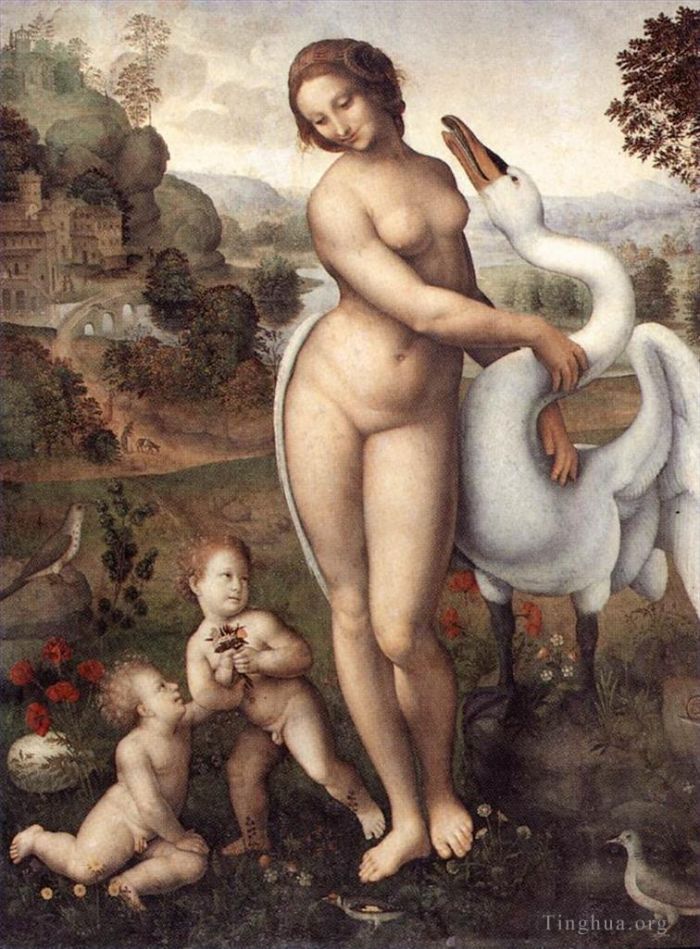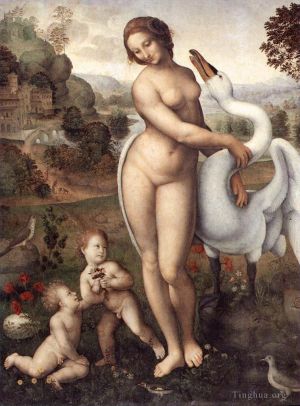Leda 1510
Leonardo da Vinci
- Price:
- Art Type: Oil Painting
- Size:
- English Comments: 0
- International Comments: 0
- Creating Date:
- Introduction and Works of Leonardo da Vinci >>
Keywords:
Leda
Work Overview
- Date: c.1510; Milan, Italy
Style: High Renaissance
Genre: mythological painting
Media: oil, panel
Dimensions: 86 x 112 cm
Location: Borghese Gallery, Rome, Italy
Leda and the Swan is a story and subject in art from Greek mythology in which the god Zeus, in the form of a swan, seduces Leda. According to later Greek mythology, Leda bore Helen and Polydeuces, children of Zeus, while at the same time bearing Castor and Clytemnestra, children of her husband Tyndareus, the King of Sparta. In the W. B. Yeats version, it is subtly suggested that Clytemnestra, although being the daughter of Tyndareus, has somehow been traumatized by what the swan has done to her mother (see below). According to many versions of the story, Zeus took the form of a swan and seduced Leda on the same night she slept with her husband King Tyndareus. In some versions, she laid two eggs from which the children hatched.[1] In other versions, Helen is a daughter of Nemesis, the goddess who personified the disaster that awaited those suffering from the pride of Hubris.
The subject was rarely seen in the large-scale sculpture of antiquity, although a representation of Leda in sculpture has been attributed in modern times to Timotheos (compare illustration, below left); small-scale sculptures survive showing both reclining and standing poses,[2] in cameos and engraved gems, rings, and terracotta oil lamps. Thanks to the literary renditions of Ovid and Fulgentius[3] it was a well-known myth through the Middle Ages, but emerged more prominently as a classicizing theme, with erotic overtones, in the Italian Renaissance.
Leonardo was very absorbed with the theme of Leda during the time he was working on Mona Lisa and while in Milan he made many sketches of the swans in the moat around the Castello. The picture was described by Cassiano del Pozzo in 1625; at this stage it was in the royal collection in Fontainebleau: "A standing figure of Leda almost entirely naked, with the swan at her and two eggs, from whose broken shells come forth four babies, This work, although somewhat dry in style, is exquisitely finished, especially in the woman's breast; and for the rest of the landscape and the plant life are rendered with the greatest diligence. Unfortunately the picture is in a bad state because it is done on three long panels which have split apart and broken off a certain amount of paint."
By the eighteenth century the artwork was completely lost to us; fortunately several things remain to give a good idea what it looked like. There are Leonardo's drawings of the head and bust of Leda; a famous drawing done in 1506 by Raphael; a red chalk drawing which may have been done by an assistant to Leonardo; a picture by Bugiardini which was based upon Leonardo's original cartoon (done in 1504); another copy probably by Francesco Melzi and based on Leonardo's second cartoon (drawn around 1508); plus a copy by another pupil, Cesare da Sesto; this final work is said to be closest to Leonardo's original and is displayed on this page. Leonardo's head and coiffure study for Leda and the Swan is signed; it should be noted that this is not his signature, having been added at a later date by one of the owners.
Of the two cartoons Leonardo did for this work one showed Leda kneeling and used mostly curved lines to suggest aa writhing movement which emphasised fertility; the other had her in a standing position. In the final painting Leda was in the second of the two poses and seeming to recoil from the swan, while at the same time showing a shy attraction towards it. Leda's head was modestly lowered giving a virginal look, in contrast her figure was opulent, a mature body with a young head on her shoulders. Like many of Leonardo's subjects her hair was painted in minute detail. She was surrounded by the most fertile landscape that Leonardo -- by this time aged 54 -- had produced since his workshop days. The swan was Jupiter in one of his many disguises and the babies were Castor and Pollux, and Helen and Clytemnestra.
- Copyright Statement:
All the reproduction of any forms about this work unauthorized by Singing Palette including images, texts and so on will be deemed to be violating the Copyright Laws.
To cite this webpage, please link back here.
- >> English Comments
- >> Chinese Comments
- >> French Comments
- >> German Comments
- >>Report
- Leda 1508
- Portrait of a musician
- The Virgin of the Rocks 1491
- Madonna and Child with Flowers (Benois Madonna)
- The Annunciation
- Madonna and Child with a Pomegranate
- Portrait of Ginevra Benci
- La belle Ferroniere
- Baptism of Christ
- St John the Baptist
- St John in the Wilderness (Bacchus)
- Madonna Litta
- Leda 1530
- The Virgin and Child with St Anne
- Madonna with the Yarnwinder 1501
- Madonna with the Yarnwinder after 1510
- Saint Jerome
- Leda 1510
- Portrait of Cecilia Gallerani (Lady with an Ermine)
- Leda and the Swan 1505
- The Madonna of the Carnation
- Mona Lisa
- Vitruvian Man
- Design for St Anne
- Study of a womans head
- Allegory with wolf and eagle
- Battle of Anghiari Tavola Doria
- Study of a rider
- Study for the Last Supper Judas
- Rearing horse
- Study sheet with horses and dragons
- Madonna and Child with St Anne and the Young St John detail1
- Studies of human skull
- Study for Madonna and Child with St Anne Drapery over the legs
- Study of hands
- Anatomical studies of the shoulder
- Star of Bethlehem and other plants
- Battle of Anghiari
- Drawing of the Torso and the Arms
- Adoration of the Magi
- Study of St Anne Mary and the Christ Child
- Ceiling decoration
- Study of horses
- Studies of Leda and a horse
- Womans Head
- Study for the Last Supper
- The Last Supper
- Landscape drawing for Santa Maria della Neve on 5th August 1473









 Singing Palette
Singing Palette